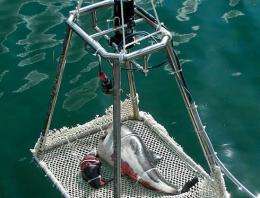First underwater observatory live online

(PhysOrg.com) -- Scientists, including those from the Natural History Museum, have developed the world's first underwater observatory connected to the internet.
Scientists, including those from the Natural History Museum, have developed the world's first underwater observatory connected to the internet, creating a window into the ocean, one of the least-studied environments on our planet.
Live images are streamed online from the observatory under the sea, which means scientists anywhere in the world are now able to study processes in real-time, helping them better understand how marine ecosystems work.
The system was created by a team from the Natural History Museum, University of Gothenburg, Maritime Museum and Aquarium Gothenburg, Scottish Association of Marine Science, OceanLab Aberdeen, and Bangor University.
Natural History Museum marine biologist Adrian Glover showed the live stream of the observatory at the Museum's grand opening of the new Darwin Centre last week with special guests Prince William and Sir David Attenborough. The state-of-the-art building lets the public get a glimpse of some of the important science research that happens at the Museum.
Current underwater studies
The observatory is currently 30m underwater in a fjord on the west coast of Sweden at the Sven Loven Centre for Marine Sciences. It is beaming images of a community of scavenging creatures living on the remains of a dead whale.
'Even something simple like the decomposition of a small whale in shallow water is very poorly known,' says Glover.
'Until now, we had to make do with 'one-off' visits using submersibles, remotely operated-vehicles or scuba divers.'
Glover is currently studying the feeding behaviour of scavenging animals that feed on the carcass. He is also hoping to study the colonisation of the bones by the bone-eating worms from the genus Osedax, one species of which he discovered in 2005.
How the observatory works
The underwater observatory is made up of a video camera and instruments that are mounted onto a frame. Video data is sent live along cables to the observatory 'node', a type of communications hub that is in a hut on a nearby island. The node is powered and connected to the internet by fibre-optic cables.
Technology advances in the cabling and underwater instruments enabled this system to work whereas a few years ago it wouldn't have been possible. However, there were some hurdles to overcome along the way, from problems with computer software and flooding of the camera housing, to a sudden infestation of barnacles!
Future use of observatory
The observatory is designed so that it can be used in potentially much greater ocean depths. 'If we are successful in raising funds, we would like to deploy our observatory in the deep sea using a remotely-operated vehicle' says Glover.
'We know even less about processes in the deep sea, and a network of observatories like these could revolutionise our perception of the marine environment.’
More information: Underwater observatory live video stream: www.kmf.gu.se/bildcenter/kamera2/
Provided by American Museum of Natural History (news : web)

















